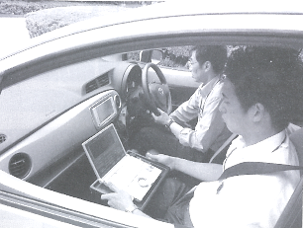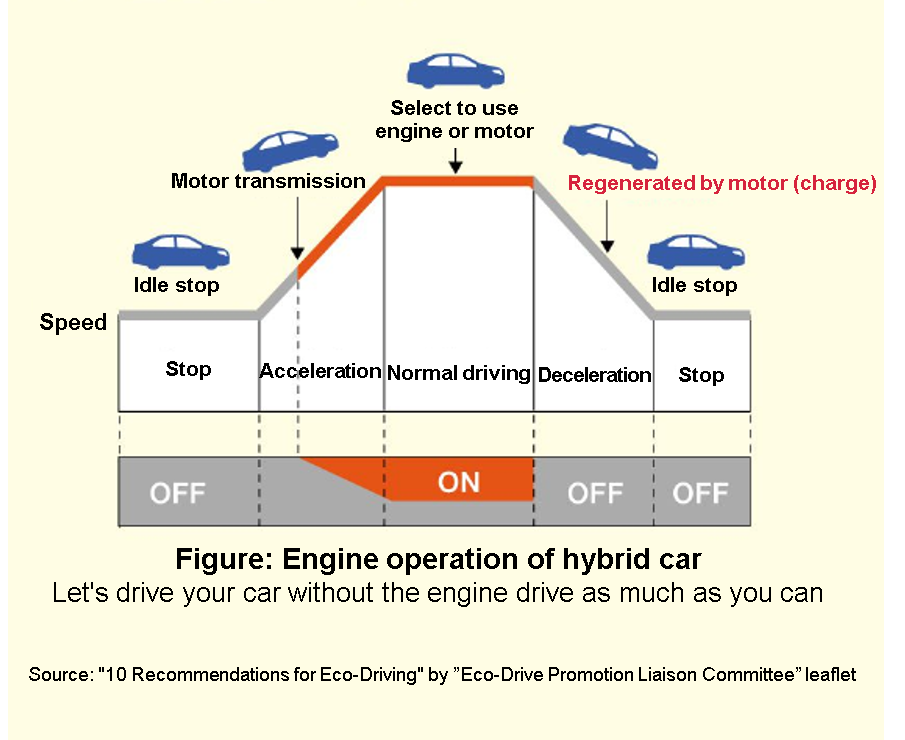“10 Recommendations for Eco-Driving” Revised
The Liaison Council on Promoting Eco-Driving, a body consisting of the National Police Agency (NPA), the Ministry of Economy, Trade and Industry (METI), the Ministry of Land, Infrastructure, Transport and Tourism (MLIT) and the Ministry of the Environment (MOE), revised the 10 Recommendations for Eco-Driving. The council formulated in 2003 the “10 Recommendations for Eco-Driving”, a compilation of recommended driving techniques, and since then, it has been enhancing public awareness of eco-driving after the two partial revisions of the compilation in 2006 and 2012. Taking into consideration that a certain period of time has passed since the last revision in 2012, these ministries and agency and related associations and entities jointly examined the compilation to decide on whether or not specific items shown in the compilation should be revised. Content are as follows.
“10 Recommendations for Eco-Driving”
Eco-driving is “driving technology” and “mindfulness” that helps to prevent global warming by reducing fuel consumption and CO2 emissions. Eco-driving also contribute to reducing the traffic accidents. Driving with low fuel consumption is not only saving cost, but also safe for your passengers. Let’s drive relax, calm down and having time to spare, this is also important to Eco-Driving. Eco-Driving is an action that anyone can start right away. Your driving skill will become improved by your habit of small consciousness, and the society will surely become better. Let’s start from what we can do, eco-driving.
“1. Ascertain the fuel efficiency of your vehicle
Let’s make it a habit to ascertain the fuel efficiency of your vehicle. By understanding the daily fuel efficiency, you can realize the eco-driving effect of yourself. It is convenient to use the Eco-Driving support functions equipped with the car such as fuel consumption meter, eco-driving navigation, and fuel consumption management on the Internet.
2. e-Start: Accelerate your vehicle gently
When starting, let’s gently step on the acceleration pedal to start (approx. 20 km / h for the first 5 seconds). In daily driving, you can improve fuel efficiency by about 10% simply by keeping a gentle start. A calm and gentle start leads to the safe driving.
3. Drive your vehicle with less acceleration and deceleration actions by keeping an adequate inter-vehicle distance
When driving, try to run at a constant speed. If the distance between vehicles is shortened, there are many opportunities for wasteful acceleration and deceleration, and fuel efficiency will deteriorate by about 2% in urban areas and about 6% in suburbs. Let’s try to drive with little speed change according to traffic conditions.
4. Release the acceleration pedal earlier when decelerating your vehicle
If you are about to stopping the car such as when the traffic signal changes red, take your foot off the acceleration pedal early. Then, the engine brake will operate and the fuel efficiency will improve by about 2%. Also, let’s use engine braking when you slow down or go down a slope.
5. Use the car air conditioner appropriately
The car air conditioner (A / C) is a function that cools and dehumidifies the inside of a car. If you only need heating, turn off the air conditioner switch. For example, the fuel efficiency will deteriorate by about 12% if the air conditioner switch is left on while the setting inside temperature is same as the outside air, e.g. 25 ℃.. in addition, let’s do not overcool the car when you need an air conditioner.
6. Stop inefficient idling of the engine
Let’s do not idle the engine when parking or stopping due to a waiting or loading / unloading of luggage (* 1). About 130cc of fuel is consumed by idling for 10 minutes (when the air conditioner is off). In addition, the current passenger cars basically do not require warm-up operation (* 2). Let’s start immediately after starting the engine.
* 1 Please note that manual idling stop, which is stopping of the engine itself at the intersection, needs some cautions in the following points. (There is no problem with the cars equipped with the automatic idling stop devices.)
・ If you press the brakes pedal several times during manual idling stop, the brake will become working ineffectively.
・ If you are not used to it, malfunctions and delays may occur at starting. Also, the engine may not restart due to the shortened life of the parts such as the battery.
・ Since safety devices such as airbags and direction indicators do not work during the idling stop, avoid manual idling stop in case of driving at top or on slopes.
* 2 Warm-up running to warm up while running is sufficient, except in special circumstances such as in extremely cold regions around -20 ℃.

Eco-driving training
7. Avoid driving in traffic jams by starting with time to spare
Before going out, check the road traffic information such as traffic jams, regulations and also the destination and route in advance by utilizing the maps and car navigation systems. For example, if you get lost in a one-hour drive and drive an extra 10 minutes, fuel consumption will increase by about 17%. Furthermore, you can save fuel and time by checking the road traffic information and avoiding traffic jams even after departure.
8. Start checking and maintenance with checking the air pressure of your tires
Let’s make it a habit to check the air pressure of tires (* 3). If the air pressure of tires is below the proper value, fuel consumption will deteriorate by 2% in urban areas and 4% in the suburbs (* 4). Also, fuel consumption can be improved by regularly replacing the engine oil, oil filter, air cleaner element, etc.
* 3 Air pressure of tires will drop by about 5% in one month.
* 4 When air pressure of tires is in shortage by 50kPa (0.5kg / cm2) below the proper value.
9. Unload the unnecessary load from your vehicle
Let’s unload the load that you don’t need to carry. The fuel efficiency of a car is greatly affected by the weight of your luggage. For example, if you carry 100kg of luggage, the fuel efficiency will deteriorate by about 3%. The fuel efficiency of a car is also sensitive to air resistance. Remove exterior parts such as ski carriers when not in use.
10. Do not park your vehicle where it blocks the passage of other vehicles
Let’s stop illegal parking. Parking in places where obstruct traffic causes traffic jam such as near intersections. Illegal parking not only worsens the fuel efficiency of other vehicles, but also causes traffic accidents. Average speed improves and fuel efficiency is prevented on the roads with less illegal parking.
Column:Eco-driving tips for hybrid cars
The revised leaflet for the enlightenment of “10 Recommendations for Eco-Driving ” including the introduction of the eco-driving tips for hybrid cars. The point is to utilize the motor as much as possible.
Start and acceleration are motor’s area of specialty
When starting, slowly run the car by the motor, and when the engine starts, gradually accelerate to the target speed with the power of the motor. After that, loosen the accelerator and fuel efficiency will improve by running the car on the motor alone as much as possible.
Brake is a big chance for the electric generation
When decelerating, release the accelerator early to step on the brake gently and stop the car slowly by taking a long distance. The electric power generated by the motor is charged into the battery by stepping on the brake gently. It improves the fuel efficiency by reusing its electric power for the next time when starting and accelerating. Refer to the figure.


